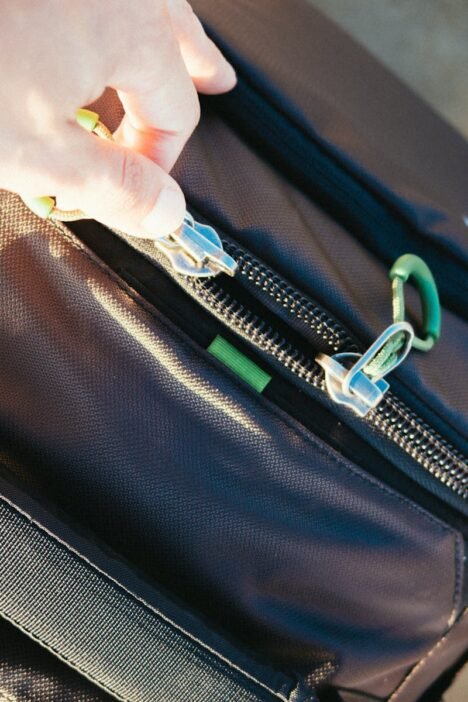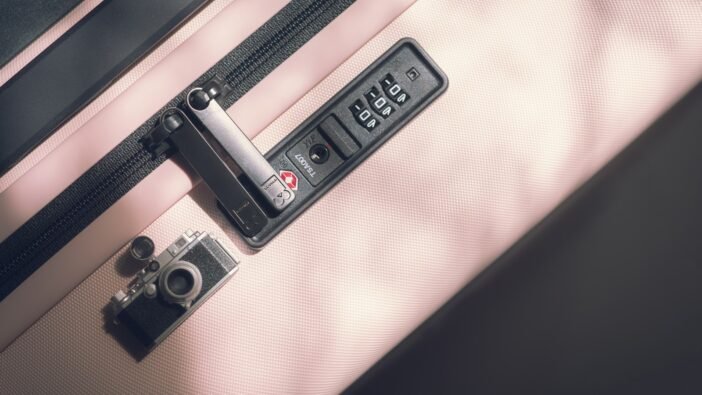Contents
We’ve all been there. You’re at the gym, focused on your workout, and your backpack is tucked away in a locker or cubby. Or perhaps you’re at a library, engrossed in a book, with your bag resting on the floor. Even a quick coffee run can mean leaving your backpack unattended for a few minutes. While we often associate lockable zippers with travel, their benefits extend far beyond securing luggage on a plane or train. In this post, we’ll explore the advantages of having lockable zippers on your everyday backpack, delving into the different types, how they work, and why they’re valuable for anyone concerned about security and peace of mind.
Understanding Lockable Zippers: Types and Mechanisms
Choosing a backpack with lockable zippers requires understanding the different options available. Not all lockable zippers offer the same level of security or convenience. We’ll examine the common types’ mechanisms and relative strengths.
Single vs. Double Slider Zippers: A Security Comparison
Single-slider lockable zippers feature a single zipper pull with a loop or hole to accommodate a small padlock. This design provides a basic level of security, primarily acting as a deterrent against opportunistic theft. The presence of a lock can discourage someone from quickly trying to unzip your bag in a crowded environment. However, it’s important to acknowledge the limitations of this design.
With enough force or the right tool, a single-slider zipper, even when locked, can sometimes be pried open. The fabric of the backpack itself, or the zipper track, can become a point of vulnerability. A double-slider zipper is strongly recommended for higher security, especially if carrying valuable items.

Double-Slider Zippers: The Gold Standard for Security
Double-slider lockable zippers are widely considered the most secure option for backpacks. They feature two zipper pulls, each with a loop or hole. These loops align when the pulls are brought together, allowing you to secure them with a single padlock. This locks the zipper at a specific point, preventing it from being opened from either end or anywhere along the track.
This design significantly increases security by eliminating the single point of failure found in single-slider zippers. Even if a thief attempts to force the zipper, the two locked sliders prevent it from being opened. This makes double-slider zippers the preferred choice for travelers, commuters, and anyone who prioritizes the security of their belongings. The vast majority of secure backpacks utilize this.
Zipper Pull Tab Locks: Convenience vs. Strength
Some backpacks incorporate locking mechanisms directly into the zipper pull tabs. These integrated locks can take various forms, such as small combination locks or miniature key-operated ones built into the pull. The primary advantage of this type of lock is convenience; you don’t need to carry a separate padlock.
However, it’s crucial to understand that zipper pull tab locks generally offer lower security than double-slider zippers with separate padlocks. The built-in locking mechanisms are often smaller and less robust, making them more susceptible to tampering or forced entry. They are best suited for deterring casual theft rather than providing high-level security.
Built-in Locking Systems: The High-End Option
A select few backpacks, often designed for specific purposes like carrying expensive camera equipment or sensitive documents, feature fully integrated locking systems. These systems go beyond simple lockable zippers and may incorporate combination locks built directly into the backpack’s frame or closure mechanism. These systems can offer excellent security.
These built-in systems often use more robust materials and sophisticated locking mechanisms, making them significantly more difficult to bypass. However, they typically come at a higher price point and may add some bulk or weight to the backpack. They represent a premium option for those who require the highest level of security for their belongings.

Materials and Durability: What to Look For
Beyond the locking mechanism type, the zipper’s overall quality and surrounding materials are paramount. A strong lock is useless if the zipper is flimsy or easily damaged. Look for backpacks that mention using durable zippers, such as those from YKK, a renowned zipper manufacturer.
The material of the loops or locking points on the zipper pulls should also be carefully considered. To resist being broken or cut, these should be made of strong metal, not flimsy plastic. The fabric surrounding the zipper should also be robust and tear-resistant, as this can be another point of vulnerability. Pay attention to the overall construction quality of the backpack to ensure that the lockable zippers are part of a well-designed, secure system.
Everyday Scenarios Where Lockable Zippers Matter
While we often associate lockable zippers with travel security, their benefits extend to numerous everyday situations. A lockable backpack can provide peace of mind and protect your belongings in various scenarios.
Commuting and Public Transportation
Crowded buses, trains, and subways are prime environments for opportunistic theft. Pickpockets often target unsuspecting commuters, taking advantage of crowded conditions and distractions. A locked backpack significantly reduces the risk of someone quickly unzipping your bag and grabbing your wallet, phone, or other valuables. At the same time, you’re focused on your commute or navigating a busy station.
Even if you’re not in a particularly crowded area, public transportation involves periods where your backpack might be out of your direct line of sight, such as when it’s stowed in an overhead compartment or luggage rack. A lock provides an extra layer of security, deterring anyone from tampering with your belongings while you cannot keep a close eye on them.
School and University Campuses
Students often carry valuable items in their backpacks, including laptops, tablets, expensive textbooks, and sometimes cash. University and school campuses, while generally safe, can still be targets for theft, particularly in libraries, common areas, or crowded lecture halls.
A lockable backpack provides a simple yet effective way to protect these valuable items. It deters casual theft and provides peace of mind, allowing students to focus on their studies without worrying about their belongings’ security. Even leaving a backpack unattended for a short period, such as during a bathroom break or while grabbing a coffee, becomes less risky with a lockable zipper.
Gyms and Fitness Centers
Gym lockers are notorious for being vulnerable to theft. While many gyms provide lockers, they often rely on simple combination locks or user-provided padlocks, which may not be the most secure. Leaving your backpack in a locker or a cubby while you work out can be a risk.
Lockable zippers on your backpack protect your wallet, phone, keys, and other essentials. Even if someone manages to access your locker, a locked backpack makes it significantly more difficult for them to steal your valuables quickly. This is especially important if you carry items like expensive headphones or smartwatches.
Cafes and Co-working Spaces
The rise of remote work has made cafes and co-working spaces increasingly popular. While generally relaxed and comfortable, these environments can also present security challenges. It’s common to see people leaving their laptops and backpacks unattended for short periods while they order food, use the restroom, or take a phone call.
A lockable backpack provides a crucial layer of security in these situations. It deters opportunistic thieves from quickly grabbing your laptop or other valuables while you’re momentarily distracted. While leaving your belongings completely unattended for extended periods is never advisable, a locked backpack significantly reduces the risk of a quick snatch-and-grab theft.
Outdoor Activities (Hiking, Biking – Light Security)
While lockable zippers aren’t a substitute for vigilance and awareness during outdoor activities, they can offer a degree of light security. For example, if you’re hiking and stop for a break, a locked backpack can deter someone from quickly rummaging through your bag while you’re admiring the view or taking photos.
Similarly, if you’re biking and stop at a cafe or store, a locked backpack can provide some protection against casual theft. It’s important to note that a determined thief could still cut the backpack or the lock, so this is more about deterring opportunistic grabs rather than providing absolute security in high-risk situations. Using just the lockable zippers is never recommended to secure the valuable and important things in the outdoors.
Choosing the Right Lock for Your Lockable Zipper
The type of lock you choose depends on your needs and preferences.
- Padlocks. If you opt for a padlock, choose the right size for the zipper loops. The shackle (the U-shaped part) should be thick enough to resist cutting but not so large that it’s cumbersome.
- Combination Locks. Combination locks eliminate the need to carry a key, which can be convenient. However, choosing a combination that’s easy for you to remember but difficult for others to guess is crucial.
- TSA-Approved Locks. While primarily designed for air travel, TSA-approved locks are a versatile option. They can be opened by TSA agents with a master key, preventing them from cutting your lock during security checks. This also makes them a good choice if you frequently travel.
Factors to consider to use the lockable zippers
While lockable zippers offer significant security benefits, using them thoughtfully and assessing your needs and risk levels is important. Having lockable zippers doesn’t guarantee absolute protection; it’s about using them strategically.
How Often Do You Need to Access Your Backpack?
Consider the frequency with which you need to access the contents of your backpack. If you’re constantly opening and closing your bag throughout the day, repeatedly locking and unlocking the zippers can become cumbersome. In these situations, you might lock your backpack only during periods of higher risk, such as during commutes or when leaving it unattended for longer durations.
For example, suppose you use your backpack primarily for work and must access your laptop and documents frequently. In that case, you might only lock it when traveling on public transportation or leaving it in a cafe. Alternatively, locking the zippers consistently might be a more practical approach if you carry less frequently accessed valuables.
What is Your Risk Assessment?
A crucial factor is your assessment of the risk level in different environments. A crowded subway station during rush hour presents a higher theft risk than a quiet, sparsely populated library. This risk assessment should inform your decision to use lockable zippers.
Consider factors like location, time of day, security personnel’s presence, and awareness of your surroundings. In high-risk environments, consistently using lockable zippers is highly recommended. In lower-risk situations, you might use them selectively or rely on other security measures, such as keeping your backpack within sight at all times. The key is to be proactive and adapt your security practices to the specific context. This is all the personal judgement.
The Value of the Contents
Consider the monetary and sentimental value of the items you are carrying. If you have easily replaceable items, using lockable zippers might add unnecessary inconvenience.
Locking the zippers is prudent if you carry valuable items that cannot be replaced. The value of your contents can help inform you on the level of security you need.
Final Thoughts
Lockable zippers are a valuable, often overlooked, feature for everyday backpacks. They significantly boost security and peace of mind, protecting your belongings in various situations, from commuting to studying to working remotely. We encourage you to consider the benefits of lockable zippers when choosing your next backpack.